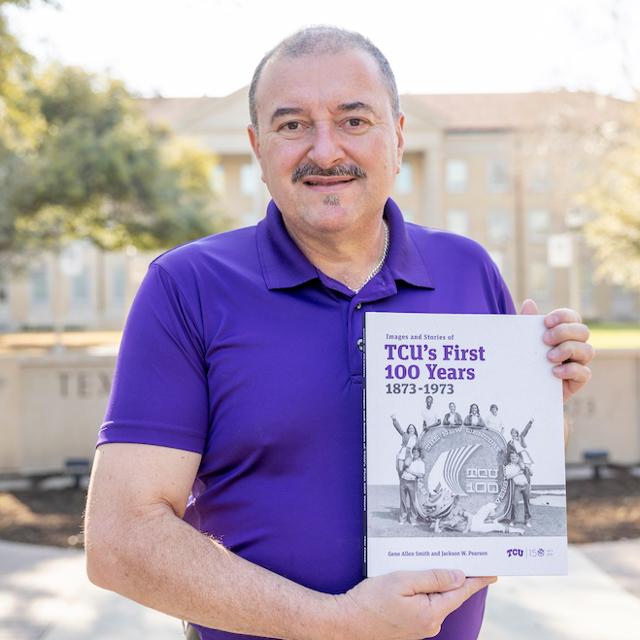
In TCU’s 150th Year, Book Captures a ‘Century of Progress’
Self-proclaimed history enthusiast Gene Smith knows a lot about TCU’s past, but there were a few surprises even he discovered while compiling the recently released book Images and Stories of TCU’s First 100 Years 1873-1973.
“I’ve done a lot on TCU and knew what topics we wanted the book to cover, but I learned some things I didn’t know,” said Smith, a TCU professor of history, the director of the Center for Texas Studies at TCU and an author, primarily on early American history.
As TCU celebrates its Sesquicentennial, a history book about the first 100 years is important, he said. For example, TCU is one of the oldest continuously coed institutions west of the Mississippi River and began integrating during the mid-1940s through its Evening College.
“We need to look back on our past to understand where we came from,” he said. “This was a fun book to do, and I think a lot of people will find it interesting as they look at a century of progress.”
Printed by TCU Press, the hardcover book is a photographic history with vignettes that Smith wrote along with graduate student Jackson Wiley Pearson and contributions from other writers.
While there are well-known stories, some will come as a surprise to readers, like the airplane that crashed into modern day Reed Hall. (Fortunately, there were no casualties.) There’s trivia, like where the oldest tree is located (spoiler alert: in front of Jarvis Hall) and why the campus’s visual identity is tied to clay-tiled roofs. The answer? During WWII, there was a shortage of asphalt, which uses petroleum, needed for the war effort.
The six chapters cover major periods for the university, with 270 pages flowing chronologically, beginning with Addison and Randolph Clark starting a school in 1869 as the Disciple-based Male and Female Seminary of Fort Worth. The school then moved to Thorp Spring, where it received a charter from the state in 1873, marking its official founding.
The Waco years, including the fateful night of March 22, 1910, when the campus Main Building went up in flames, follows. Next is the return to Fort Worth that same year and the building of today’s campus in the then-grassland south of downtown.
The rest of the book follows natural breaks in history, like WWII and the Civil Rights movement, along with the rise of TCU – from foundation to construction and expansion and the period where the university really began to make its mark.
The impact of people, including students, faculty and alumni, is central to the book. Smith most admires McGruder Sadler, who served as chancellor from 1941 to 1965, and who visualized the campus footprint.
“He also brought competitive sports to TCU and really put the university on the map,” he said.
Additionally, the city of Fort Worth is recognized as part of TCU’s story, as over the past 100 years the two merged and share a valuable connection of growth, enrichment and community, he said.
Throughout the book, there is an underlying theme.
“It’s about TCU’s journey, from a small private university growing to one on the national stage, about a college advancing, growing and trying to make a mark on society.”
Copies of the book are available through TCU Press and at TCU Campus Store.
Learn about other 150th commemorative books including Walking TCU: A Historic Perspective, A History to Remember: TCU in Purple, White, and Black, A Remarkable Story to Tell and A Hope of Wisdom.
